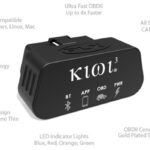Encountering a P0300 code when you use your OBD scanner can be concerning. This trouble code, triggered in your vehicle’s engine control unit (ECU), signals “Random/Multiple Cylinder Misfire Detected.” But what does this actually mean for your car, and more importantly, how can you resolve it? As an automotive repair expert at obd2scanner.store, I’m here to break down the P0300 code, explain its common causes, and guide you through the diagnostic and repair process.
Understanding the P0300 Code: Random/Multiple Cylinder Misfire
The P0300 code indicates that your engine is experiencing misfires in more than one cylinder, or the misfire is random and the system cannot pinpoint a specific cylinder. A misfire occurs when the combustion process in one or more of your engine’s cylinders is incomplete or doesn’t happen at all. This can lead to a rough-running engine, decreased fuel efficiency, and potential damage to your catalytic converter if left unaddressed. While a P0300 code itself doesn’t tell you the exact cause of the misfire, it’s a critical first step in diagnosing a broader engine issue.
Common Causes of OBD Scanner Code P0300
Several factors can contribute to a P0300 code. Pinpointing the exact cause is crucial for effective repair. Here are some of the most frequent culprits:
Ignition System Issues
- Worn or Fouled Spark Plugs: Spark plugs are essential for igniting the air-fuel mixture in your engine. Over time, spark plugs wear out, becoming less effective. This is one of the most common causes of P0300.
- Weak Ignition Coils: Ignition coils provide the high voltage spark to the spark plugs. A failing or weak ignition coil may not deliver sufficient spark, leading to misfires.
Fuel System Problems
- Clogged or Faulty Fuel Injectors: Fuel injectors are responsible for spraying precise amounts of fuel into the cylinders. If injectors are clogged or malfunctioning, they can disrupt the fuel delivery, causing misfires.
- Low Fuel Pressure: A failing fuel pump or a clogged fuel filter can lead to insufficient fuel pressure, resulting in lean fuel conditions and misfires.
Vacuum and Exhaust Leaks
- Vacuum Leaks: Vacuum leaks can disrupt the air-fuel mixture by allowing unmetered air into the engine. This imbalance can cause misfires across multiple cylinders.
- Exhaust Leaks: While less common, exhaust leaks near the oxygen sensors can sometimes cause false misfire readings and trigger a P0300 code.
Engine Mechanical Issues
- Timing Issues: Incorrect engine timing can disrupt the combustion process in multiple cylinders, leading to random misfires.
- Cylinder Head Gasket Failure: In more severe cases, a failed cylinder head gasket can cause compression loss between cylinders, resulting in significant misfires and a P0300 code.
Is it Safe to Drive with a P0300 Code?
While a P0300 code might not immediately leave you stranded, it’s not advisable to ignore it. Driving with persistent misfires can lead to:
- Reduced Engine Performance: You’ll likely notice a decrease in power and acceleration.
- Poor Fuel Economy: Misfires reduce the efficiency of your engine, wasting fuel.
- Catalytic Converter Damage: Unburnt fuel from misfires can overheat and damage the catalytic converter, a costly repair.
- Further Engine Damage: Prolonged misfires can lead to more serious engine damage over time.
Therefore, it’s best to diagnose and address a P0300 code as soon as possible to prevent further complications and expenses.
Diagnosing the P0300 Error Code
Diagnosing a P0300 code effectively involves a systematic approach:
- Use an OBD Scanner: Connect an OBD-II scanner to your vehicle’s diagnostic port. Note down the P0300 code and any other related codes that may be present. Additional codes can provide valuable clues about the specific system affected.
- Check for Cylinder Specific Misfire Codes: While P0300 is a random misfire code, sometimes it’s accompanied by codes like P0301, P0302, etc., which indicate misfires in specific cylinders (cylinder 1, cylinder 2, etc.). These codes can help narrow down the problem area.
- Inspect Spark Plugs: Visually inspect the spark plugs for wear, damage, or fouling. Replace spark plugs as needed, following your vehicle’s maintenance schedule.
- Test Ignition Coils: Use a multimeter or a spark tester to check the resistance and output of each ignition coil. Replace any weak or faulty coils.
- Evaluate Fuel Injectors: Listen for the clicking sound of fuel injectors to check if they are firing. Fuel injector testing and cleaning may require professional equipment.
- Check for Vacuum Leaks: Inspect vacuum lines and intake manifold gaskets for leaks. Use a vacuum gauge or smoke tester to pinpoint leaks.
- Perform a Compression Test: If basic checks don’t resolve the issue, a compression test can identify potential cylinder compression problems, such as valve or head gasket issues.
How to Fix OBD-II Code P0300
The fix for a P0300 code depends entirely on the underlying cause. Common solutions include:
- Spark Plug Replacement: Replace worn or fouled spark plugs with the correct type for your vehicle.
- Ignition Coil Replacement: Replace faulty ignition coils.
- Fuel Injector Cleaning or Replacement: Clean or replace clogged or malfunctioning fuel injectors.
- Fuel Pump or Fuel Filter Replacement: Replace a failing fuel pump or clogged fuel filter to restore proper fuel pressure.
- Vacuum Leak Repair: Repair or replace vacuum lines or gaskets to eliminate vacuum leaks.
- Timing Adjustment or Repair: Correct engine timing issues.
- Cylinder Head Gasket Replacement: In severe cases, replace a failed cylinder head gasket.
After performing any repairs, clear the P0300 code using your OBD scanner and test drive your vehicle to ensure the misfire is resolved and the check engine light remains off.
Dealing with a P0300 code can seem daunting, but by systematically diagnosing the potential causes and using an OBD scanner, you can effectively pinpoint and resolve the issue. Remember to consult your vehicle’s repair manual, like a Haynes manual, for specific procedures and specifications. And for all your OBD scanning needs, visit obd2scanner.store for reliable and effective tools to keep your vehicle running smoothly.

